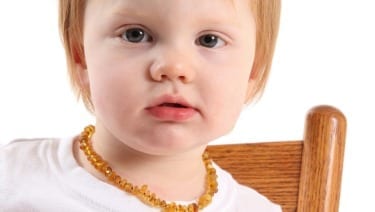When parents see their baby suffering, they just want a solution. Teething necklaces and beads have become an increasing popular alternative treatment to ease teething pain. But, are they effective and safe? The answer is no.
The Food and Drug Administration (FDA) released an official warning in December 2018 after recieving reports of children choking on beads that break off and an 18-month-old being strangled to death by an amber necklace during a nap.
Teething Necklaces: Watch Out For Faulty ClaimsTeething necklaces and bracelets are made of amber, wood, marble or silicone. They are marketed to relieve teething pain and sometimes are used to provide sensory stimulation to people with attention-deficit/hyperactivity disorder. According to Dr. Andrew Weil, a world-renowned leader and pioneer in the field of integrative medicine, the use of these necklaces is not supported by modern science. Retailers claim that when warmed by the baby’s body temperature, the amber releases a pain-relieving substance that is then absorbed through the skin into the bloodstream. Additionally, promoters claim that they stimulate the thyroid gland (to control drooling) and improve the ability of the immune system to reduce inflammation in the ears, throat, stomach and respiratory system. However, there is currently no scientific research or evidence to back up these claims. |
Why These Teething Necklaces and Beads are Choking and Strangulation Hazards:
“The risk is two-fold — strangulation and choking,” said pediatrician Natasha Burgert, MD, FAAP. It occurs when the necklaces are worn around a child’s neck, especially when unsupervised (such as while sleeping) or if the child were to break the necklace and swallow the beads. However, those risks are not only for these teething necklaces.
The American Academy of Pediatrics (AAP) does not recommend that infants wear any jewelry. Suffocation is the leading cause of death for children under a year old and among the top five causes of death for children between the ages of 1 and 4.
Parents who choose to use these necklaces are advised to:
- Always supervise your child when he or she is wearing the necklace or bracelet.
- Have your child wear the necklace on a wrist or ankle and not around his or her neck.
- Remember to remove the necklace or bracelet when your child is unattended, even if it is only for a short period of time!
- Remove the necklace or bracelet while your child is sleeping (day or night).
- Consider using alternate forms of teething pain relief (see suggestions below).
- Talk to your child’s pediatrician if you have concerns or questions about your child’s health.
Safer Ways to Soothe a Teething Baby:
There are many teething-pain relievers that can soothe your baby’s sore gums safely. Here are a few worth trying:
- Chew toys. Plastic and rubber toys are great for soothing aching gums.
- Cold things. For help numbing and easing the ache and inflammation, try using damp washcloths that have been twisted and frozen (tie one end in a knot for better gnawing). Avoid teething rings that are frozen solid; they are too hard for children’s mouths.
- Massage. A light, gentle rub or massage might give your little one a lot of relief. Remember to wash your hands, then massage the sore areas in your baby’s mouth with your finger or knuckle.
- Medicine. When your baby is having a really tough time, ask your pediatrician about giving a dose of acetaminophen (Tylenol). Note: Numbing gels or creams that contain benzocaine are not recommended for infants.
Additional Information:
- Baby Teething Pain
- Baby’s First Tooth: 7 Facts Parents Should Know
- Teething: 4 to 7 Months
- How to Help Teething Symptoms without Medications
- Prevention of Choking Among Children (AAP Policy Statement)
- To review recalls and safety information, visit the Consumer Product Safety Commission (CSPC) website.
- Last Updated
- 12/20/2018
- Source
- American Academy of Pediatrics (Copyright © 2018)

